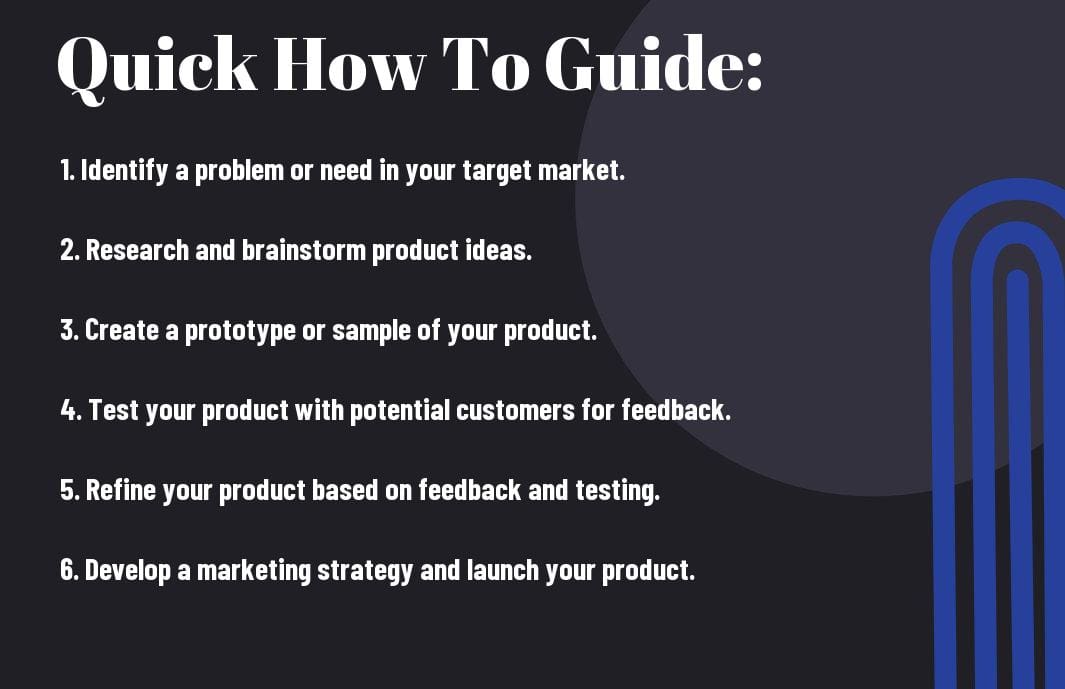This comprehensive guide aims to walk you through the exciting journey of creating your first physical product. From ideation to market launch, we will cover each crucial step in the process with clarity and detail. Whether you’re a budding entrepreneur or a seasoned professional looking to expand your product line, this guide will provide you with necessary insights and practical tips to help you navigate the complexities of bringing a physical product to life. By the end of this how-to guide, you will be equipped with the knowledge and confidence to turn your innovative ideas into tangible products that meet market demands and exceed customer expectations.
Key Takeaways:
- Market research is crucial: Before creating your first physical product, it is important to conduct thorough market research to understand the demand, competition, and target audience.
- Prototype and test your product: It is crucial to create a prototype of your physical product and test it extensively to ensure that it functions properly and meets the needs of your target market.
- Focus on quality and customer feedback: To succeed in the market, prioritize the quality of your product and listen to customer feedback to make necessary improvements and adjustments.


Conceptualizing Your Product
Brainstorming Ideas and Identifying Market Needs
Even before you start working on your physical product, it is crucial to have a clear understanding of the market needs and gaps that your product will address. To brainstorm ideas effectively, consider your own interests and passions, conduct market research, and analyze competitor products to identify areas where you can innovate and offer something unique.
Evaluating Feasibility and Factors for Success
To ensure the success of your physical product, you need to evaluate its feasibility and consider various factors that can impact its market acceptance and profitability. Clearly outline your target market, assess manufacturing costs, distribution channels, and pricing strategies, and conduct a thorough SWOT analysis to identify strengths, weaknesses, opportunities, and threats.
- Market Research: Analyze market trends and consumer preferences.
- Cost Analysis: Calculate all expenses involved in production and distribution.
- Competitor Analysis: Identify key competitors and differentiate your product.
- SWOT Analysis: Evaluate internal strengths and weaknesses, along with external opportunities and threats.
It’s important to remember that evaluating the feasibility of your product and considering various factors for success is a continuous process. After conducting initial assessments, be prepared to adapt your strategies as needed to ensure the viability and competitiveness of your product in the market.
Design and Development
Creating Initial Designs and Prototyping
Keep in mind that the first step in creating a physical product is to come up with initial designs and develop prototypes. Assuming you have a clear idea of what you want to create, sketch out your product design on paper or use digital tools to create 3D models. Once you have a visual representation, start developing prototypes to test functionality and usability.
Tips for Sourcing Materials and Components
There’s a vital aspect in the design process that involves sourcing the right materials and components for your product. Creating a bill of materials detailing all the necessary components will help you streamline the sourcing process and ensure you have everything you need. Research suppliers, request samples, and compare prices to find the best quality materials at competitive prices. Any delays or issues in material sourcing can significantly impact your overall production timeline.
- Research suppliers
- Request samples
- Compare prices
- Any delays or issues in material sourcing can significantly impact your overall production timeline.
The Production Process
How-To Choose the Right Manufacturing Partner
Many first-time product creators underestimate the importance of choosing the right manufacturing partner. It is crucial to find a partner who aligns with your values, can meet your production needs, and is reliable. Research potential partners thoroughly, ask for samples, and inquire about their experience with similar products.
Factors to Consider During Mass Production
Many factors need to be considered during mass production to ensure the success of your product. Quality control, production capacity, lead times, and cost are some of the key factors to keep in mind. It’s imperative to work closely with your manufacturer and regularly monitor the production process to avoid any unwanted surprises.
- Quality control must be consistently maintained throughout production.
- Production capacity should meet your demand without compromising on quality.
- Lead times need to be clearly communicated and adhered to for timely delivery.
- Cost plays a significant role in determining the feasibility of your product.
This comprehensive approach will help you navigate the challenges of mass production effectively, ensuring a successful outcome for your physical product.
Bringing Your Product to Market
Pricing Strategies and Distribution Channels
To successfully bring your product to market, you need to carefully consider your pricing strategies and distribution channels. Conduct market research to understand your target audience’s price sensitivity and willingness to pay. Ensure that your pricing covers your costs while remaining competitive in the market. Choose distribution channels that align with your product and target market, whether it’s through retailers, online platforms, or direct sales.
Marketing Tips for Promoting Your Physical Product
To effectively promote your physical product, you must develop a comprehensive marketing strategy that showcases its unique selling points and benefits. Utilize a mix of online and offline marketing channels to reach your target audience, including social media, email marketing, influencer partnerships, and traditional advertising. Create compelling content that educates and entertains your audience while highlighting the value of your product. Engage with your customers through feedback and reviews to build trust and loyalty.
- Utilize social media, email marketing, and influencer partnerships
- Create compelling content that highlights the value of your product
- Engage with customers through feedback and reviews
Another crucial aspect of marketing your physical product is to identify your target market and tailor your messaging to their needs and preferences. By understanding your audience, you can create targeted campaigns that resonate with them and drive sales. Additionally, monitor your marketing efforts closely to track their effectiveness and make adjustments as needed to optimize your strategy for maximum impact.
Post-Launch Insights
Collecting Customer Feedback and Managing Reviews
If you are not actively seeking feedback from your customers, you are missing out on a goldmine of information that can help you improve your product and grow your business. Encourage customers to leave reviews on your website or on popular review platforms. Monitor these reviews regularly and address any issues promptly to show that you value customer feedback.
Scaling Your Product Line and Exploring Future Opportunities
Now is the time to think about how you can expand your product line and capitalize on the success of your first physical product. Consider introducing complementary products or variations of your existing product to appeal to a wider audience. Explore new sales channels and partnerships to reach more customers and drive growth for your business.
Collecting customer feedback and staying on top of reviews is crucial for the success of your product. Positive reviews can help build trust with new customers, while negative reviews provide valuable insights for improvement. Take all feedback seriously and use it to make informed decisions about your product and business strategy.
Final Words
With these considerations in mind, you now have a clear step-by-step guide to follow in creating your first physical product. By carefully planning each stage from idea generation to design and manufacturing, you can increase your chances of success in bringing your product to market. Remember to stay focused on your target audience, continuously iterate on your design based on feedback, and keep a close eye on cost management throughout the process. By following this comprehensive how-to guide, you can navigate the complexities of creating a physical product with confidence and efficiency.
FAQ
Q: What is the importance of creating a physical product?
A: Creating a physical product offers a tangible representation of your ideas and can provide a sense of accomplishment. It allows you to reach a wider audience and can be a source of revenue if marketed effectively.
Q: How do I start the process of developing my first physical product?
A: To begin developing your first physical product, start by identifying a problem that your product can solve. Conduct market research to understand your target audience’s needs and preferences. Create a prototype and test it before moving on to manufacturing.
Q: What are the key steps involved in bringing a physical product to market?
A: The key steps involved in bringing a physical product to market include designing the product, sourcing materials and manufacturers, creating a marketing strategy, setting up distribution channels, and ensuring quality control. It’s important to also consider packaging, pricing, and customer support throughout the process.




